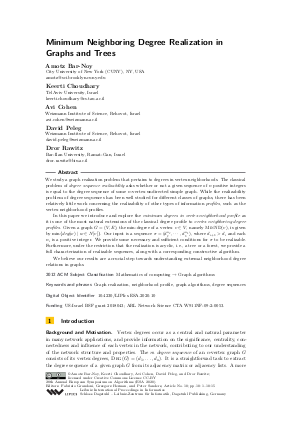Minimum Neighboring Degree Realization in Graphs and Trees
Authors Amotz Bar-Noy, Keerti Choudhary, Avi Cohen, David Peleg, Dror Rawitz
-
Part of:
Volume:
28th Annual European Symposium on Algorithms (ESA 2020)
Part of: Series: Leibniz International Proceedings in Informatics (LIPIcs)
Part of: Conference: European Symposium on Algorithms (ESA) - License:
 Creative Commons Attribution 3.0 Unported license
Creative Commons Attribution 3.0 Unported license
- Publication Date: 2020-08-26
File

PDF
LIPIcs.ESA.2020.10.pdf
- Filesize: 0.79 MB
- 15 pages
Document Identifiers
Subject Classification
ACM Subject Classification
- Mathematics of computing → Graph algorithms
Keywords
- Graph realization
- neighborhood profile
- graph algorithms
- degree sequences
Metrics
- Access Statistics
-
Total Accesses (updated on a weekly basis)
0PDF Downloads0Metadata Views
Abstract
We study a graph realization problem that pertains to degrees in vertex neighborhoods. The classical problem of degree sequence realizability asks whether or not a given sequence of n positive integers is equal to the degree sequence of some n-vertex undirected simple graph. While the realizability problem of degree sequences has been well studied for different classes of graphs, there has been relatively little work concerning the realizability of other types of information profiles, such as the vertex neighborhood profiles.
In this paper we introduce and explore the minimum degrees in vertex neighborhood profile as it is one of the most natural extensions of the classical degree profile to vertex neighboring degree profiles. Given a graph G = (V,E), the min-degree of a vertex v ∈ V, namely MinND(v), is given by min{deg(w) ∣ w ∈ N[v]}. Our input is a sequence σ = (d_𝓁^{n_𝓁}, ⋯ , d₁^{n₁}), where d_{i+1} > d_i and each n_i is a positive integer. We provide some necessary and sufficient conditions for σ to be realizable. Furthermore, under the restriction that the realization is acyclic, i.e., a tree or a forest, we provide a full characterization of realizable sequences, along with a corresponding constructive algorithm.
We believe our results are a crucial step towards understanding extremal neighborhood degree relations in graphs.
Cite As Get BibTex
Amotz Bar-Noy, Keerti Choudhary, Avi Cohen, David Peleg, and Dror Rawitz. Minimum Neighboring Degree Realization in Graphs and Trees. In 28th Annual European Symposium on Algorithms (ESA 2020). Leibniz International Proceedings in Informatics (LIPIcs), Volume 173, pp. 10:1-10:15, Schloss Dagstuhl – Leibniz-Zentrum für Informatik (2020)
https://doi.org/10.4230/LIPIcs.ESA.2020.10
BibTex
@InProceedings{barnoy_et_al:LIPIcs.ESA.2020.10,
author = {Bar-Noy, Amotz and Choudhary, Keerti and Cohen, Avi and Peleg, David and Rawitz, Dror},
title = {{Minimum Neighboring Degree Realization in Graphs and Trees}},
booktitle = {28th Annual European Symposium on Algorithms (ESA 2020)},
pages = {10:1--10:15},
series = {Leibniz International Proceedings in Informatics (LIPIcs)},
ISBN = {978-3-95977-162-7},
ISSN = {1868-8969},
year = {2020},
volume = {173},
editor = {Grandoni, Fabrizio and Herman, Grzegorz and Sanders, Peter},
publisher = {Schloss Dagstuhl -- Leibniz-Zentrum f{\"u}r Informatik},
address = {Dagstuhl, Germany},
URL = {https://drops.dagstuhl.de/entities/document/10.4230/LIPIcs.ESA.2020.10},
URN = {urn:nbn:de:0030-drops-128765},
doi = {10.4230/LIPIcs.ESA.2020.10},
annote = {Keywords: Graph realization, neighborhood profile, graph algorithms, degree sequences}
}
Author Details
Funding
US-Israel BSF grant 2018043; ARL Network Science CTA W911NF-09-2-0053.
References
-
Martin Aigner and Eberhard Triesch. Realizability and uniqueness in graphs. Discrete Mathematics, 136:3-20, 1994.

-
Amotz Bar-Noy, Keerti Choudhary, David Peleg, and Dror Rawitz. Realizability of graph specifications: Characterizations and algorithms. In 25th SIROCCO, LNCS, pages 3-13, 2018.

-
Amotz Bar-Noy, Keerti Choudhary, David Peleg, and Dror Rawitz. Efficiently realizing interval sequences. In 30th ISAAC, pages 47:1-47:15, 2019.

-
Amotz Bar-Noy, Keerti Choudhary, David Peleg, and Dror Rawitz. Graph profile realizations and applications to social networks. In 13th WALCOM, LNCS, pages 1-12, 2019.

-
Amotz Bar-Noy, Keerti Choudhary, David Peleg, and Dror Rawitz. Graph realizations: Maximum degree in vertex neighborhoods. In Proc. SWAT, 2020.

-
Michael D. Barrus and Elizabeth A. Donovan. Neighborhood degree lists of graphs. Discrete Mathematics, 341(1):175-183, 2018.

-
Joseph K. Blitzstein and Persi Diaconis. A sequential importance sampling algorithm for generating random graphs with prescribed degrees. Internet Mathematics, 6(4):489-522, 2011.

-
Sheshayya A. Choudum. A simple proof of the Erdös-Gallai theorem on graph sequences. Bull. Austral. Math. Soc., 33(1):67-70, 1991.

-
Brian Cloteaux. Fast sequential creation of random realizations of degree sequences. Internet Mathematics, 12(3):205-219, 2016.

-
Paul Erdös and Tibor Gallai. Graphs with prescribed degrees of vertices [hungarian]. Matematikai Lapok, 11:264-274, 1960.

-
S.L. Feld. Why your friends have more friends than you do. Amer. J. Sociology, 96:1464-1477, 1991.

-
S. Louis Hakimi. On realizability of a set of integers as degrees of the vertices of a linear graph - I. SIAM J. Appl. Math., 10(3):496-506, 1962.

-
Peter L. Hammer, Toshihide Ibaraki, and Bruno Simeone. Threshold sequences. SIAM J. Algebraic Discrete Methods, 2(1):39-49, 1981.

-
V. Havel. A remark on the existence of finite graphs. Casopis Pest. Mat., 80:477-480, 1955.

-
P.J. Kelly. A congruence theorem for trees. Pacific J. Math., 7:961-968, 1957.

-
Milena Mihail and Nisheeth Vishnoi. On generating graphs with prescribed degree sequences for complex network modeling applications. 3rd ARACNE, 2002.

- Elchanan Mossel and Nathan Ross. Shotgun assembly of labeled graphs. CoRR, abs/1504.07682, 2015. URL: http://arxiv.org/abs/1504.07682.
-
Peter V. O'Neil. Ulam’s conjecture and graph reconstructions. Amer. Math. Monthly, 77:35-43, 1970.

-
Gerard Sierksma and Han Hoogeveen. Seven criteria for integer sequences being graphic. J. Graph Theory, 15(2):223-231, 1991.

-
Amitabha Tripathi and Himanshu Tyagi. A simple criterion on degree sequences of graphs. Discrete Applied Mathematics, 156(18):3513-3517, 2008.

-
Regina Tyshkevich. Decomposition of graphical sequences and unigraphs. Discrete Mathematics, 220(1-3):201-238, 2000.

-
S.M. Ulam. A collection of mathematical problems. Wiley, 1960.

-
D.L. Wang and D.J. Kleitman. On the existence of n-connected graphs with prescribed degrees (n > 2). Networks, 3:225-239, 1973.

-
N.C. Wormald. Models of random regular graphs. Surveys in Combin., 267:239-298, 1999.

